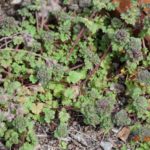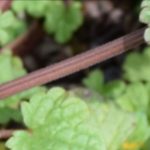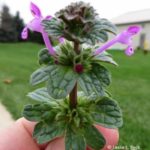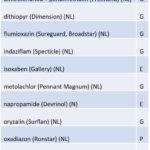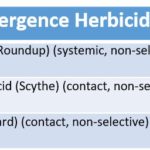- Figure 1. Henbit in a landscape bed.
Biology:
Henbit (Lamium amplexicaule) is a common winter annual broadleaf weed found throughout the United States. It can often be mistaken for another closely related winter annual broadleaf, purple deadnettle. Both can be observed by their showy pink to purple flowers which are primarily produced in April, but can appear from March to November in Indiana.
- Figure 2. Square stems on henbit indicate that it is in the mint family
Identification:
Henbit is a winter annual, meaning that it germinates in the fall, survives the winter as a vegetative plant which eventually flowers, develops seed, and dies as temperatures increase in late spring to early summer. As a member of the mint family, henbit has a characteristic four-sided (square) stem which can be sparsely hairy and greenish to purplish in color. All henbit leaves are hairy. Upper leaves are deeply lobed and encircle the main stem at the base (no leaf stem). In contrast, purple deadnettle leaves are more triangular, less deeply lobed, and are more reddish in color than henbit. Henbit flowers are small, pinkish-purple with darker coloring on the lower petal, arranged in whorls, and are tubular in shape.
- Figure 3. Henbit flower.
Cultural Control:
Mulching landscape beds at a depth of three inches can reduce germination of many weeds, including henbit. The air space between the chips create an environment not conducive to germination. Preventing weeds in the lawn will aide in reducing the weed seed bank in the landscape beds. In nurseries, cultivation is an effective treatment for reducing henbit populations.
Biological Control:
There are some organic postemergence herbicides available to control henbit. For example, pelargonic acid (Scythe) and acetic acid (5% or greater solutions) may be used to manage weeds. Other products such as Eugenol, which contain medium-length fatty acids and clove oil, have shown also some promise as an effective weed control tool.
Chemical Control:
Preemergence:
Preemergence herbicides are the recommended method for controlling henbit in nurseries and landscapes. Preemergence herbicides will reduce risks of phytotoxicity, reduce the total amount of herbicides applied, and reduce labor inputs. The herbicide must be applied PRIOR to germination for control. A fall application of preemergence herbicide is necessary to control henbit. See table 1 for preemergence herbicides that are labeled on ornamentals for controlling henbit.
- Table 1. Labeled preemergence herbicides for henbit control. E=excellent control G=good control P=poor control
Postemergence:
Postemergence herbicides may be used when escapes occur with the preemergence application. Glyphosate works well on henbit, but be cautious when applying around the ornamental plants in the nursery or landscape. See Table 2 for labeled postemergence herbicides that are effective on henbit.
- Table 2. Postemergence herbicides for henbit control.
References:
Neal, J. C., Derr, J., Marble, C., and Senesac, A. 2017. Nursery and Landscape Weed Control. Southeastern US Pest Control Guide for Nursery Crops and Landscape Plantings. 9 pgs.
